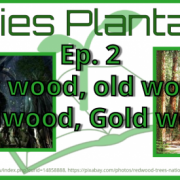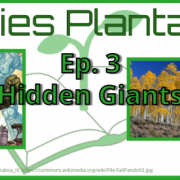Stories Plantarum E6: Saving the Forest Through the Trees Transcript

Episode Description_______________________________________________
This episode focuses on the heroic conservation story in Dr. Seuss’s The Lorax, the real-life tree that may have inspired Truffula Trees, and a real-life environmental and human rights activist Wangari Maathai, who created a movement that to this day, has planted millions of trees.
Link to transcript: community.plantae.org/path/5355984225331840491
Link to watch Taking Root documentary: (English) www.youtube.com/watch?v=Wjs0F8FdSCw
(All other languages) vimeopro.com/marlboroproduction…of-wangari-maathai
Link to listen to “The Leopard and the Lung” by The Joy Formidable :www.youtube.com/watch?v=8cbJHq2JqYE
Follow and get in contact on social media!
Twitter: @PlantarumPod
Facebook: facebook.com/PlantarumPod
Hosted by Rebecca Hayes, @BigGirlPlants on Twitter.
________________________________________________________________________
Prefer to listen to the episode? Links below!
Apple Podcasts (rate and subscribe if you enjoy the show!)
Soundcloud (listen in browser, no programs to download)
________________________________________________________________________
Welcome back to Stories Plantarum, the podcast all about fabulous flora from sci-fi and fantasy and real-life plants that seem out of this world. I’m your host Rebecca Hayes, and today we’re discussing a fictional tree whose leaves are used to make what is possibly the most useful product in the whole universe, and a two part segment about the real life tree that may have inspired Dr. Seuss’s The Lorax and an incredible activist whose love for trees helped her change the world. I wanted to apologize that I didn’t get an episode out in November, but in return I promise to have one more episode before the end of the year. Alright, as always thanks for listening and now let’s dig in to Stories Plantarum, Episode 6: Saving the Forest Through the Trees.
For this story, we’re marching through the idyllic hills of Dr. Seuss’s Truffula Valley, the only place on the planet that can support the iconic tree for which the valley is named.
Truffula trees grow up to 25 meters tall and are considered evergreens despite the year-round vivid colors of their fluffy foliage. Their bark is dark gray with white or yellow bands, while their fuzzy leaves can be bright pink, red, orange, or yellow and are soft as silk.
The leaves form a swirling spherical crown that apparently smells like sweet butterfly milk. The tree produces panicles of small flowers similar to Hydrangea, that develop into purple grape-like berries. These berries attract hungry brown Barb-a-loots, a type of bear endemic to Truffula Valley that dines primarily on Truffula berries. Young Barb-a-loots also will take refuge inside the cozy Truffula leaves when threatened.
Truffula seeds are black with a distinct swirl pattern and are famously slow to germinate. A seed can take up to 10 months to germinate, ten years to reach sapling height, and another ten years to full maturity. This sluggish growth habit left Truffula trees vulnerable to overexploitation by greedy individuals.
Dr. Seuss’s The Lorax film follows the conservation efforts of a boy named Ted to rescue Truffula trees from extinction. Ted was raised in the climate-controlled plasticine paradise of Thneedville. You heard that right, Thneedville. The entire town of Thneedville exists in a literal bubble: due to toxic levels of air pollution and extreme habitat degradation, the citizens of Thneedville spend their days within the walls of the city surrounded by the latest models of robotic plants. Most people in the town had never even seen a real plant. Ted was inspired to take up conservation for the noblest of reasons: to impress a cute girl. His crush Audrey declared that she would marry someone if they gave her a real tree, so of course Ted knew what he had to do. Following a tip from his wise grandmother, Ted ventures outside the town in search of the Once-ler who would supposedly know a thing or two about trees.
The Once-ler tells Ted a capitalistic story of prosperity and crushing defeat. As a young gentleman, the Once-ler stumbled into Truffula Valley in search of raw materials for his nascent textile design business. To the horror of the friendly forest creatures, the Once-ler unceremoniously chopped down a Truffula tree and began harvesting its luxurious leaves to spin into thread.
This odious offense summoned an ancient forest guardian called the Lorax, who demanded that the Once-ler leave the forest and the trees alone. Unshaken, the Once-ler continues shamelessly chopping down trees to produce a prototype.
With the Truffula thread, he invented a multipurpose garment called the Thneed, for which the town was eventually named after. In the movie, they sing a song about this, but I’m just gonna read you a list of all of the various uses for this unbelievably functional fashion:
· Shirt
· Sock
· Large glove
· Hat
· Carpet
· Pillow
· Sheet
· Curtains
· Cover for bicycle seats
· Hammock
· Toothbrush holder
· Canary nest
· Sweatshirt
· Thneedle Thoup that supposedly cures backache and chest pain (yet nobody knows how it does this or why)
· It makes a perfect windshield wiper
· And you can use it to groom your hair when it gets mussed
· And also eliminates carborater rust
· Sweater
· Umbrella
· Towel
· Skirt
· Pants
· Blindfold
· Shoes
· Cape
· Swimsuit
· Sponge
· Scarf
· Tightrope
· Slightly disturbingly, a butterfly net (considering how the plant smells like butterfly milk I think it’s kinda sad that baby butterflies are just flying into these thneed nets but that’s for a different podcast)
· A thing for exercise
· Wig
· A Purse/a bag
· A suit
· Boxing gloves
· Parachute
· A reusable diaper
· And a runny nose wiper
· Slingshot
· A muzzle
· Jump rope
· A food tastes like bread but without the crust
· A tobacco substitute
· A viper trap
· And finally a mustache brush
Naturally, with all of those uses, the Thneed was a hit indeed. Such a hit that within a few years of its inception, Thneed development directly caused the extinction of every last Truffula tree in the valley. The Lorax was no match for the Once-ler’s thirst for wealth. Tragically, the Once-ler realized too late the importance of the trees for maintaining the rest of the valley ecosystem, and was left alone in desolation with the final remaining Truffula seed.
Moved by the Once-ler’s tale and suddenly no longer in it just to get the girl, Ted accepts the challenge of planting the Truffula seed in the center of Thneedville. This action was sorely opposed by the leader of Thneedville, a corporate tycoon who made his riches selling bottled air and strongly hates trees for giving it away for free. Ted, his grandma, and Audrey are able to foil every attempt to stop them and succeed in planting the seed and inspiring the rest of the citizens of Thneedville to take up planting trees themselves. The story closes with the first creatures returning to their native valley and the Lorax reuniting with the Once-ler to congratulate him on finally doing the right thing.
Dr. Seuss himself has said that The Lorax was the only children’s book of his that was explicitly propaganda and also was one of his proudest works. He penned it just as the environmental protection movement became globally popular in the 1970s and he watched as the tree-covered hills around him were logged to make way for condos.
——–
There’s not a consensus on what type of tree inspired the Truffula tree. Dr. Seuss has never mentioned it and his wife supposed that he was inspired by the Kenyan flora they had seen on safari, while others guess that a grand Monterey Cypress visible from his desk in his San Diego home was what sparked the idea. For this next part, I’m gonna tell you more about the Monterey Cypress, and about an amazing real-life activist that spoke not only for the trees, but for the rights of all humankind.
______
Despite being native to only two groves along the Pacific coast in Carmel, CA, the Monterey Cypress has become an unlikely and beloved landscape ornamental around the world. Recent DNA analyses indicate that the Monterey Cypress is divergent from the old-world Cypress trees. The scientific name Hesperocyparis macrocarpa reflects this: the genus means “Western, or new cypress” and the epithet means “large fruit”, likely in reference to their sizable seed cones. Monterey Cypress trees are sculpted by their environment: warped and wizened branches grow twisted in the high oceanic winds topped by tufts of needles reminiscent of the colorful crowns of the Truffula Tree. All of the tallest Monterey Cypresses are found outside their native range, where they can focus on upward growth rather than desperately clinging to sea cliffs. Under ideal conditions, Monterey Cypress trees can live over 250 years, with the eldest reported at 284 years old. Although greater heights may be reached by trees outside their native range, expatriated trees face novel challenges in unfamiliar habitats.
Trees growing on sea cliffs must adapt to a uniquely harsh environment: high winds, extreme saltiness, dense fog, and rocky soil all present problems for saplings. The Monterey Cypress is perfectly matched to this undesirable habitat. As a halophyte, or “salt-plant”, the Monterey Cypress is able to avoid taking on critical levels of saline to protect its leaves from shriveling in the salty mist. Interestingly, the trees suffer in more amenable environments.
Away from the windy, salty moisture of their native groves, Monterey Cypress trees are prone to fungal attacks that cause Cypress Canker Disease, to which there is no cure besides culling the tree to prevent the spread of the Seiridium fungus. Cypress Canker Disease causes seeping sores that ooze sticky sap that is irresistible to beetles. Ironically, the tree’s only defense is to produce a surplus of sap to try and drown out the beetles, which unfortunately can attract even more beetles. This cycle is a death sentence for unhealthy Monterey Cypress trees, and without copious amounts of water for the tree to use in sap production, even the strongest plants can succumb. It seems that the harsh coastal environment is actually part of what protects the Monterey Cypress, as trees within their native range are immune to those hazards.
Pat Welsh, a contributor to the San Diego Reader, perfectly summed up the strength of native Monterey Cypress trees in 1998 as “Here, where they belong, cypress trees are like living sermons in courage, tenacity, and grit. They don’t ask for life to be easy; they live in the very teeth of the wind and relish the challenge. A Monterey cypress growing old in its native habitat is a good example of joyous and dignified survival.”
Wood from the Monterey Cypress has been used in the past for musical instruments, boat-building, cabinet-making and flooring, and firewood. The foliage is slightly toxic to grazing animals and has been known to cause miscarriages in cattle.
Monterey Cypress is one of the most common trees planted in Golden Gate Park, however many of the San Franciscan trees are dying from Cypress Canker Disease and other issues.
If you were hoping to see the specific tree that may have inspired the Truffula trees, I have some bad news for you.
Plagued by years of termite damage, the tree known to locals as “The Lorax Tree” fell in June of 2019. The town is planning to plant a replacement in the near future.
Luckily, there’s an even more iconic Monterey Cypress that you can visit. Known as “The Lone Cypress”, this tree stands alone on a coastal granite hillside in Pebble Beach, CA on the property of one of the most expensive golf courses in the country. Entry to 17-Mile Drive where it’s located costs a small admission, however the views are certainly worth it. This individual tree is thought to be one of if not the most photographed trees in North America. Some good news even if you’ve already seen the Lone Cypress: a storm earlier this year knocked the leftmost branch from the tree, permanently changing its silhouette. It’s time to update that picture!
——-
The Lorax may be a fictional story, however its underlying message of the value of conservation resonates all throughout the real world. The story of the Lorax is disconcertingly familiar. In a time like the present where humans are faced with unprecedented environmental destruction caused by greedy individuals, we need a real-life champion to look to for guidance and inspiration. The worlds of fiction and reality combined couldn’t come up with a more fit leader than Dr. Wangari Maathai.
———
Dr. Maathai was born in Nyeri, Kenya in 1940. As a young woman, she travelled to the United States to complete a biological sciences degree at Mount St. Scholastica College in Atchison, KS, followed by a Master of Science degree at my alma mater, the University of Pittsburgh, PA, and a Ph. D. from the University of Nairobi.
Dr. Maathai was the first woman in all of East and Central Africa to earn a doctoral degree in 1971. This accomplishment was the first of several major “firsts” for this extraordinary woman.
As a girl, Dr. Maathai was inspired to pursue science by the natural world around her. In particular, Dr. Maathai was fascinated by the incredible flora that inhabited the streambanks from which she would collect water and play. Her mother told her that the stoic fig trees on the banks were trees of God and so should be respected and protected. Upon her return to Kenya after completing her degrees in the US, Dr. Maathai was horrified to find a dramatic change in the landscape. Government-sanctioned deforestation had caused streams to dry up, plant life to disappear, firewood to become scarce, and once-abundant food sources to become limited. These changes were not lost on the women of Dr. Maathai’s community whose daily lives relied on the forest’s bounty. Dr. Maathai realized that humans cutting down trees was akin to digging their own graves.
As a member of Kenya’s National Council of Women, Dr. Maathai developed an idea for community-based tree planting that aspired to counteract the damage that rampant deforestation inflicted on the land. Women were paid a small amount of money for each tree they planted, and were also supported through workshops to teach the importance of environmental justice and how environmental rights relate to human rights. This initiative blossomed into the Green Belt Movement in 1976, a grassroots organization that focuses on poverty reduction and environmental conservation through tree planting.
According to the Green Belt Movement’s website, “The Green Belt Movement instituted seminars in civic and environmental education, now called Community Empowerment and Education seminars (or CEE), to encourage individuals to examine why they lacked agency to change their political, economic, and environmental circumstances. Participants began to understand that for years they had been placing their trust in leaders who had betrayed them and that they were sabotaging their lives by not working for the common good and failing to use their natural resources wisely.”
Dr. Maathai’s work with the Green Belt Movement led her to found the Wangari Maathai Institute for Peace and Environmental Studies at the University of Nairobi with the goal of uniting GBM members with academic researchers studying “land use, forestry, agriculture, resource-based conflicts, and peace studies”.
In 2004, Dr. Maathai was the first African woman awarded the Nobel Peace Prize for her conservation and human rights work, then was named a UN Messenger of Peace in 2009.
Dr. Maathai passed away on September 25 of 2011 at the age of 71. Her incredible life was celebrated around the world at ceremonies in in Kenya, New York, San Francisco, and London.
Her legacy lives on through the work at the Wangari Maathai Institute as well as through the very active Green Belt Movement, which continues to be a powerful force for conservation and human rights. To this day, they’ve planted millions of trees.
Much of the information I talked about today came from the amazing documentary about Dr. Maathai’s life called Taking Root: The Vision of Wangari Maathai by Lisa Merton and Alan Dater, I highly suggest checking it out if you want to learn more about her story. I’ll post a link in the show notes, but it’s available to stream online for free in 12 languages.
The Green Belt Movement’s website sums up the lasting impact of Dr. Maathai: “The work of Professor Maathai and the Green Belt Movement continues to stand as a testament to the power of grassroots organizing, proof that one person’s simple idea—that a community should come together to plant trees, can make a difference.”
Finally, I wanted to share that I learned about Dr. Maathai after looking up song lyrics to Welsh alternative rock band The Joy Formidable’s 2013 song “The Leopard and The Lung”, only to learn that the song was inspired by Dr. Maathai’s activism. Dr. Maathai served as a Goodwill Ambassador for the Congo Basin Forest Ecosystem, a vital environmental resource thought of as “the world’s ‘second lung’ after the Amazon Rainforest”, and she was “the leopard at the throats” of the anti-environmental government.
As we round out this episode, I’d like to leave you with some inspirational and timely words of wisdom from the Drs. Seuss and Maathai.
In Taking Root, Dr. Maathai describes her activism as “a little more than just the planting of trees, its planting of ideas, its giving people a reason why they should stand for their rights”.
And in Dr. Seuss’s The Lorax, the Lorax leaves us with a call to action for the environment: “Unless someone like you cares a whole awful lot, nothing is going to get better. It’s not.”
Alright, that’s all I have for this episode of Stories Plantarum. If you enjoyed the show, please rate, comment, and subscribe on iTunes, it helps other people find the show. Follow us on twitter @PlantarumPod and facebook.com/PlantarumPod, feel free to reach out with any feedback or suggestions for future episodes. You can also find infographics about each episode there. Full episode transcripts and graphics with image descriptions are available at community.plantae.org. I’ll be back next episode with more tales from the weird and wacky world of plants.
_____________________________________________________________________________
Stories Plantarum is written and produced by me, Rebecca Hayes. Intro music is “Age of Technology” by DP Music, and outro music is “Business Talk” by DP Music. Songs featured in this episode in order of appearance are “Goddess of Flowers” by Dee Yan-Key, “Pine Apple Rag” by Scott Joplin, “Old Ralley” by Lobo Loco, “Old Dancehouse” by Lobo Loco, “Moonwalk” by Lobo Loco, “Supermoon” by Ikebe Shakedown, and “The Ally” by Ikebe Shakedown, all available on the Free Music Archive. The Lorax comes from Dr. Seuss’s 1971 children’s book The Lorax and the 2012 animated film of the same name. Sources for the The Lorax include several Dr. Seuss Wiki pages including “Truffula Tree” and “Thneed”, an Eden Project profile on Truffula Trees, a Huffington Post article by Ed Mazza titled “Real-Life Truffula Tree Said To Have Inspired ‘The Lorax’ By Dr. Seuss Falls”, and a Smithsonian.com article by Katherine J. Wu titled “New Research Suggests Dr. Seuss Modeled the Lorax on This Real-Life Monkey”.
Sources for the Monterey Cypress background info included US Forest Service fact sheet on Monterey Cypress, the Cupressus macrocarpa Wikipedia page, a hilltromper.com article by Neil Khosla titled “A Local Legend”, the conifers.org profile on Cupressus macrocarpa, the Wikipedia page for the Lone Cypress, the Santa Barbara Beautiful website Tree of the Month page on Monterey Cypress, and a 1998 San Diego Reader article by Pat Welsh titled “The heartbreaking Monterey cypress”. The sources for the background on Wangari Maathai were the Green Belt Movement website and the 2008 documentary Taking Root: The Vision of Wangari Maathai.
__________________________________________________________________________
Sources:
“A Local Legend | Santa Cruz.” Accessed November 14, 2019. https://hilltromper.com/article/local-legend.
“Biography | The Green Belt Movement.” Accessed November 4, 2019. https://www.greenbeltmovement.org/wangari-maathai/biography.
“Cupressus Macrocarpa.” In Wikipedia, October 31, 2019. https://en.wikipedia.org/w/index.php?title=Cupressus_macrocarpa&oldid=923961495.
“Cupressus Macrocarpa (Monterey Cypress) Description.” Accessed November 4, 2019. https://www.conifers.org/cu/Cupressus_macrocarpa.php.
“International Editions » Taking Root.” Accessed November 4, 2019. http://takingrootfilm.com/take-action/international-versions/.
“Lone Cypress.” In Wikipedia, October 14, 2019. https://en.wikipedia.org/w/index.php?title=Lone_Cypress&oldid=921284015.
Santa Barbara Beautiful. “Monterey Cypress,” March 1, 2019. https://sbbeautiful.org/monterey-cypress/.
“Our History | The Green Belt Movement.” Accessed November 4, 2019. https://www.greenbeltmovement.org/who-we-are/our-history.
“Real-Life Truffula Tree Said To Have Inspired ‘The Lorax’ By Dr. Seuss Falls | HuffPost.” Accessed November 4, 2019. https://www.huffpost.com/entry/lorax-tree-falls-san-diego_n_5d086863e4b0953278392b78.
“The Heartbreaking Monterey Cypress | San Diego Reader.” Accessed November 4, 2019. https://www.sandiegoreader.com/news/1998/jan/15/pull-it-roots-you-fall-love-it/#.
“Thneed | Dr. Seuss Wiki | FANDOM Powered by Wikia.” Accessed November 4, 2019. https://seuss.fandom.com/wiki/Thneed.
“Truffula Tree | Dr. Seuss Wiki | FANDOM Powered by Wikia.” Accessed November 4, 2019. https://seuss.fandom.com/wiki/Truffula_Tree.
“Truffula Tree Plant Facts – The Lorax at the Eden Project.” Accessed November 4, 2019. https://www.edenproject.com/learn/for-everyone/plant-profiles/truffula-tree.
Wu, Katherine J. “New Research Suggests Dr. Seuss Modeled the Lorax on This Real-Life Monkey.” Smithsonian. Accessed November 25, 2019. https://www.smithsonianmag.com/science-nature/new-research-suggests-dr-seuss-modeled-lorax-on-this-real-life-monkey-180969692/.
Accessed November 14, 2019. http://hort.ufl.edu/trees/CUPMACA.pdf.










Leave a Reply
Want to join the discussion?Feel free to contribute!